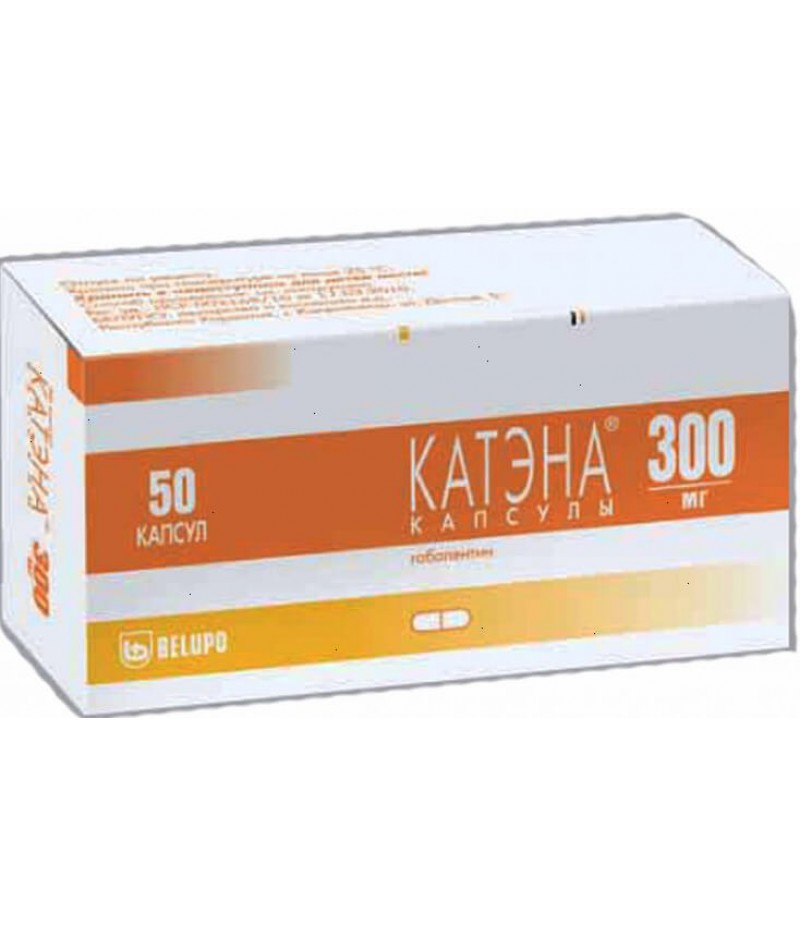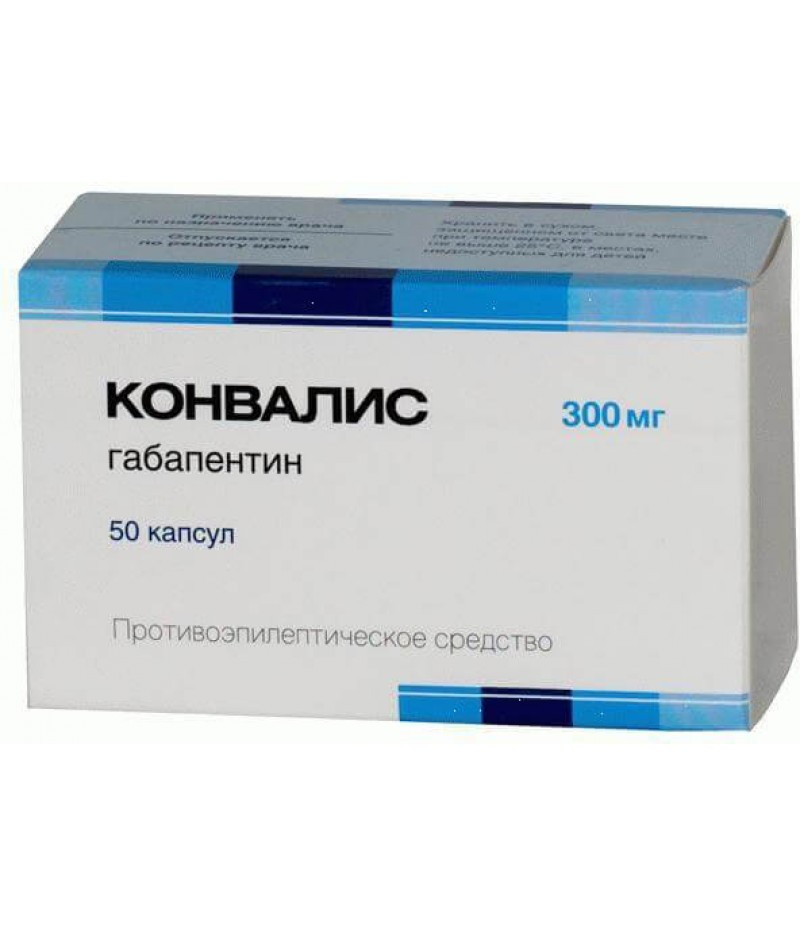Catena (Katena) caps 300mg #50
- $27.72
- 3 or more $27.45
- Availability:In Stock
Instruction for CatenaYou can buy Catena herepharmachologic effectAnticonvulsant drug. Gabapentin is structurally similar to the neurotransmitter GABA (GABA), but its mechanism of action differs from that of some other drugs that ..
Tags: caps
Instruction for Catena
You can buy Catena here
pharmachologic effect
Anticonvulsant drug. Gabapentin is structurally similar to the neurotransmitter GABA (GABA), but its mechanism of action differs from that of some other drugs that interact with GABA receptors, including valproate, barbiturates, benzodiazepines, inhibitors of GABA-transaminase reuptake inhibitors GABA agonists, GABA and prodrugs of GABA : it does not possess GABA-ergic properties and does not affect the seizure and metabolism of GABA.
Preliminary studies have shown that gabapentin binds to the α2-δ-subunit of voltage-dependent calcium channels and inhibits the flow of calcium ions, which plays an important role in causing neuropathic pain. Other mechanisms involved in the action of gabapentin in neuropathic pain include: reducing glutamate-dependent neuronal death, increasing GABA synthesis, suppressing the release of neurotransmitters of the monoamine group.
At clinically relevant concentrations, gabapentin does not bind to receptors of other common drugs or neurotransmitters, including the GABAA, GABAH, benzodiazepine, glutamate, glycine or N-methyl-D-aspartate receptors.
Unlike phenytoin and carbamazepine, gabapentin does not interact with sodium channels.
Pharmacokinetics
Suction
The bioavailability of gabapentin is not proportional to the dose, with increasing dose, it decreases. After oral ingestion, Cmax gabapentin in plasma is reached in 2–3 hours. The absolute bioavailability of gabapentin in capsules is about 60%. Food, including high in fat, no effect on pharmacokinetics. Removal of gabapentin from plasma is best described using a linear model.
Distribution
Pharmacokinetics do not change with repeated use. Css in plasma can be determined based on the results of a single dose of Catena. Gabapentin is practically not bound to plasma proteins (d - 57.7 l.
Metabolism
Signs of metabolism in humans is not detected.
Catena does not induce mixed-function oxidative liver enzymes involved in drug metabolism.
Removal
T1 / 2 plasma does not depend on the dose and averages 5-7 hours. Excreted exclusively by the kidneys in unchanged form.
Pharmacokinetics in special clinical situations
The clearance of gabapentin from plasma is reduced in the elderly and in patients with impaired renal function. The elimination rate constant, plasma clearance, and renal clearance are directly proportional to creatinine clearance. Gabapentin is removed from plasma by hemodialysis. In patients with impaired renal function and patients receiving treatment with hemodialysis, dose adjustment is recommended.
It has been established that plasma concentrations of gabapentin in children aged 4 to 12 years are generally similar to those in adults.
Indications
treatment of neuropathic pain in adults (18 years and older). Efficacy and safety in patients under the age of 18 years have not been established;
monotherapy of partial seizures with epilepsy with secondary generalization and without it in adults and children over the age of 12 years. The efficacy and safety of monotherapy in children under the age of 12 years have not been established;
as an additional tool in the treatment of partial seizures with epilepsy with secondary generalization and without it in adults and children aged 3 years and older. The safety and efficacy of additional gabapentin therapy in children less than 3 years old have not been established.
Contraindications for Catena
children up to 3 years;
Hypersensitivity to gabapentin or auxiliary components of Catena.
Precautions should be prescribed for renal failure.
Application for violations of renal function
Precautions should be prescribed Catena for renal failure.
Patients on hemodialysis who have not previously taken gabapentin, Catena is recommended to be prescribed in a saturating dose of 300-400 mg, and then apply it 200-300 mg every 4 hours of hemodialysis.
Use in children
Contraindicated in children up to 3 years.
Dosage and administration
Catena drug is administered orally, regardless of the meal. If it is necessary to reduce the dose, discontinue Catena or replace it with an alternative means, this should be done gradually over at least one week.
Neuropathic pain in adults
The initial daily dose is 900 mg (in 3 doses in equal doses); if necessary, depending on the effect, the dose is gradually increased to a maximum of 3.6 g / day. Treatment can begin immediately with a dose of 900 mg / day (300 mg 3 times / day) or during the first 3 days the dose can be increased gradually to 900 mg per day according to the following scheme:
1st day: 300 mg 1 time / day;
2nd day: 300 mg 2 times / day;
3rd day: 300 mg 3 times / day.
Partial seizures
Adults and children over the age of 12
Effective dose - from 900 mg to 3.6 g per day. Therapy can be started with a dose of 300 mg 3 times / day on day 1 or increased gradually to 900 mg according to the scheme described above (see section Neuropathic pain in adults). Subsequently, the dose may be increased to the maximum - 3.6 g / day in 3 doses in equal doses. The maximum interval between doses when taking Catena three times should not exceed 12 hours in order to avoid the resumption of seizures. A good tolerability of Catena in doses up to 4.8 g / day.
Children aged 3-12 years
The initial dose of Catena varies from 10 to 15 mg / kg / day, which is prescribed in equal doses 3 times / day and increased to an effective dose in about 3 days. The effective dose of gabapentin in children aged 5 years and older is 25-35 mg / kg / day in equal doses in 3 doses. The effective dose of gabapentin in children aged 3 to 5 years is 40 mg / kg / day in equal doses in 3 doses. There was a good tolerability of Catena in doses up to 50 mg / kg / day with prolonged use. The maximum interval between doses of Catena should not exceed 12 hours in order to avoid the resumption of seizures.
There is no need to control the concentration of gabapentin in plasma. The drug Catena can be used in combination with other anticonvulsants without taking into account changes in its plasma concentration or the concentration of other anticonvulsant drugs in serum.
Patients on hemodialysis who have not previously taken gabapentin, Catena is recommended to be prescribed in a saturating dose of 300-400 mg, and then apply it 200-300 mg every 4 hours of hemodialysis.
Use during pregnancy and lactation
Data on the safety and efficacy of Catena during pregnancy are not available, so the use of gabapentin in pregnancy is possible only if the intended benefit to the mother justifies the possible risk to the fetus.
Gabapentin is excreted in breast milk, so during treatment, breastfeeding should be abandoned.
Side effects of Catena
Since the cardiovascular system: the symptoms of vasodilation, hypertension.
On the part of the digestive system: dyspepsia, flatulence, nausea, vomiting, abdominal pain, constipation, diarrhea, dry mouth or throat, anorexia, gingivitis, dental disease, increased appetite, increased activity of hepatic transaminases.
On the part of the musculoskeletal system: myalgia, arthralgia, back pain, increased bone fragility.
Nervous system disorders: drowsiness, dizziness, ataxia, amnesia, confusion, incoordination, fatigue, impaired thinking, tremor, hypoesthesia, depression, dysarthria, insomnia, nervousness, nystagmus, increased, weakened or absent reflexes, asthenia, anxiety, hostility, hyperkinesia, emotional lability.
On the part of the respiratory system: pharyngitis, rhinitis, shortness of breath, cough, pneumonia, bronchitis, respiratory infections.
From the urinary system: urinary tract infections, impotence.
From the senses: blurred vision, amblyopia, diplopia.
On the part of the blood-forming organs: leukopenia, purpura (most often it is described as bruises that occurred during physical injury).
Allergic reactions: skin rash, itching, acne.
Other: fever, viral infection, weight gain, pain of different localization, peripheral edema, swelling of the face, headache.
Post-registration experience of application
There have been cases of sudden unexplained death, whose connection with treatment with gabapentin is not established.
Other adverse effects: acute renal failure, allergic reactions, including urticaria, alopecia, angioedema, generalized edema; fluctuations in blood glucose concentration in patients with diabetes mellitus, chest pain, an increase in the volume of the mammary glands, gynecomastia, increased liver function, exudative erythema multiforme (including Stevens-Johnson syndrome), hallucinations, movement disorders such as choreoathetosis , dyskinesia and dystonia, palpitations, pancreatitis, tinnitus, thrombocytopenia, urinary incontinence, myoclonus.
special instructions
With joint therapy with morphine, an increase in the concentration of gabapentin may occur in patients. It is necessary to ensure careful monitoring of patients for the development of such a sign of central nervous system depression as drowsiness. In this case, the dose of gabapentin or morphine should be adequately reduced.
When gabapentin and other anticonvulsants are used together, false-positive results have been recorded when determining protein in the urine using the Ames N-Multistix SG® test strips. To determine protein in the urine, it is recommended to use a more specific precipitation method sulfosalicylic acid.
Influence on ability to drive motor transport and control mechanisms
During the treatment period, it is necessary to refrain from driving vehicles and practicing potentially hazardous activities that require increased concentration and psychomotor speed.
Interaction
With simultaneous use of gabapentin and morphine, when morphine was taken 2 hours before taking gabapentin, there was an increase in the average AUC value of gabapentin by 44% compared with gabapentin monotherapy, which was associated with an increase in pain threshold (cold pressor test). The clinical significance of this change has not been established, and the pharmacokinetic characteristics of morphine did not change. The side effects of morphine when taken together with gabapentin did not differ from those of taking morphine together with placebo.
The interaction between gabapentin and phenobarbital, phenytoin, valproic acid and carbamazepine was not observed. The pharmacokinetics of gabapentin in the equilibrium state are the same in healthy people and patients receiving other anticonvulsants.
The simultaneous use of gabapentin with oral contraceptives containing norethisterone and / or ethinyl estradiol was not accompanied by changes in the pharmacokinetics of both components.
The simultaneous use of gabapentin with antacids containing aluminum and magnesium is accompanied by a decrease in the bioavailability of gabapentin by about 20%. Gabapentin is recommended to be taken approximately 2 hours after taking an antacid.
Probenecid does not affect the renal excretion of gabapentin.
A slight decrease in the renal excretion of gabapentin while taking cimetidine at the same time probably has no clinical significance.
Overdose
Symptoms: dizziness, double vision, impaired speech, drowsiness, lethargy and diarrhea.
Treatment: gastric lavage, taking activated charcoal, symptomatic therapy. Hemodialysis may be indicated in patients with severe renal insufficiency.
Shelf life - 3 years. Do not use after the expiration date.
Storage conditions
Catena should be kept out of reach of children at a temperature not exceeding 25 ° C
Terms of sell
The prescription is not required to buy Catena.


